Call it a blood Moon, supermoon, harvest Moon, a portent of the apocalypse, or just a regular ol' total lunar eclipse — for those who caught a glimpse, last night's celestial event did not disappoint.
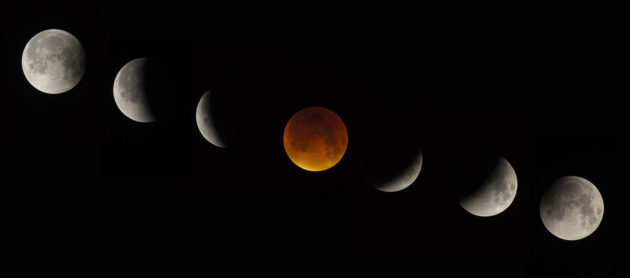
Sky & Telescope editors had been looking forward to last night's total lunar eclipse for a multitude reasons. For starters, there's something incredible about eclipses of any kind — they have a way of altering our perspective, changing the way we experience and relate to the Sun and Moon. And last night's total lunar eclipse was the last one that we'll see until January 2018, plenty of motivation to enjoy the event to the fullest.
Last but not least, we also planned a live webcast of the event, complete with a full line-up of experts. Unfortunately, the incredible amount of traffic drove Livestream to its knees (not just for our feed, but for those of Griffith Observatory, NASA, and Slooh as well). So while many were able to watch the webcast live, not everybody who wanted to was able to tune in.
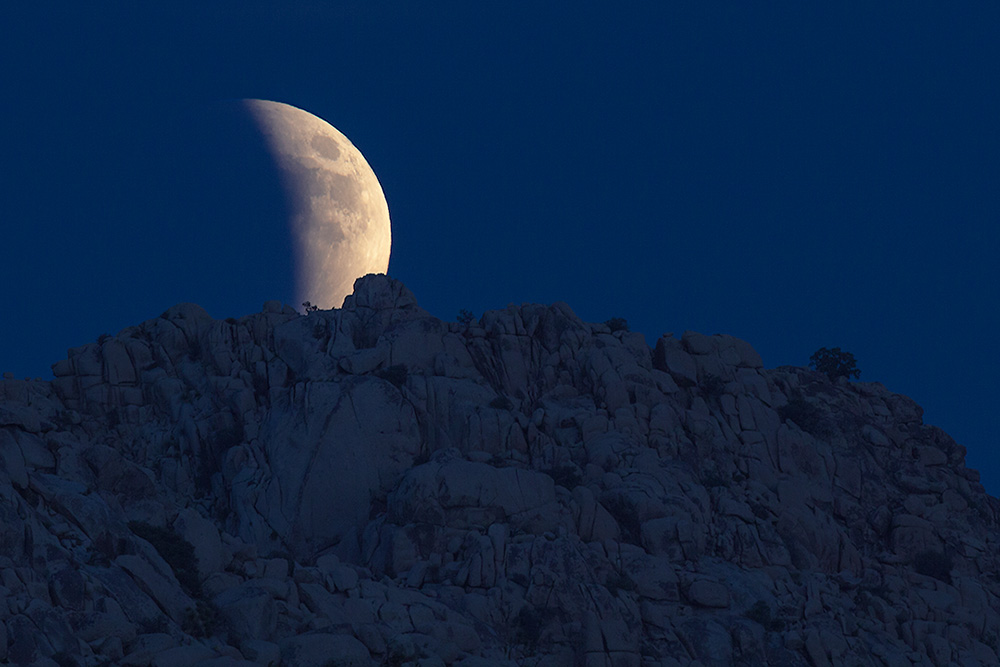
Pauline Acalin / Online Photo Gallery
S&T Senior Editor Kelly Beatty shares his decidedly digital experience of viewing the lunar eclipse:
When Sky & Telescope's editors decided to webcast September 27th's total lunar eclipse, we suspected it would be popular. After all, it was the last of four consecutive total lunar eclipses in a row; it occurred almost exactly when the Moon was closest to Earth for all of 2015; and it would be last total lunar eclipse visible anywhere until January 31, 2018.
Our "nerve center" was the main studio of Chelmsford TeleMedia, a local public-access facility in my hometown. Thanks to the Herculean efforts of producer Dan Silvia (with assists from Dan's dad, Carl, and CTM engineer Tom Peterson), it all came together seamlessly. They streamed our high-definition video feed directly to Livestream.com.
The webcast featured continuous coverage of the eclipsed Moon and provided audio-only interviews with lunar experts to describe the event and to discuss current lunar research. Guests familiar to S&T readers — Alan MacRobert, Sean Walker, Chuck Wood, and Andy Chaikin — were joined by scientists Maria Zuber (MIT) and Erich Karkoschka (University of Arizona). Telescopic Moon views came courtesy of volunteers Bruce Berger, George Pacquin, and Joe Wolfe of the Amateur Telescope Makers of Boston.
Even the weather cooperated! A big storm system off the Carolina coast threatened to move northward, spoiling our view from the Boston area. But it weakened just in time, and we enjoyed a clear, "picture-perfect" night sky. Moonrise was spectacular, a positive harbinger for the night ahead.
As sometimes happens, I found myself stuck inside the studio coordinating the interviews, so only occasionally did I get to pop outside for a quick look at the celestial goings-on overhead. But I could tell that totality was rather dark — more so than I expected.
Ours wasn't the only eclipse webcast last night, but it proved wildly popular. At last check, our lunar-eclipse webcast had been visited 1.5 million times. In fact, long after the eclipse ended thousands of viewers were still coming to the page to see what the eclipse was all about. It's great that we were able to show them this special celestial event!
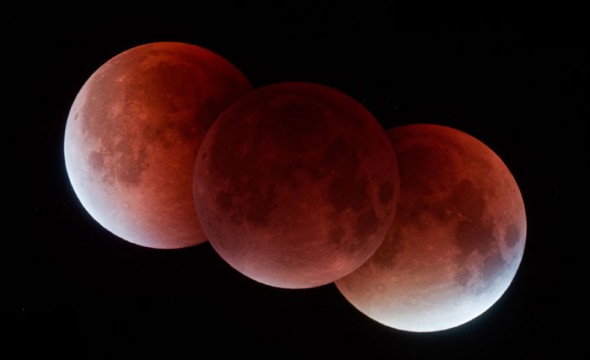
Christoph Rollwagen
A total lunar eclipse is also a perfect opportunity for public outreach because the eclipse is visible without any optical aid — so if you're waiting for a view through the telescope, binoculars and naked-eye views will do. From Monica Young, S&T's web editor:
Before I took an invitation to visit the Harvard College Observatory for the lunar eclipse, I'd already been hearing plenty about the “Super-Harvest-Apocalypse-Blood Moon!” So it didn't surprise me when I arrived to see a record-breaking turnout. The observatory filled up long before I got there, and the line to get in kept growing until it snaked all the way through the long parking lot and down to the street. I waited an hour just to get inside and another hour to get a fabulous view of the Moon’s illuminated limb through the 9-inch Clark refractor.
But waiting is fun when you have good company and a pair of 10×50 binoculars to pass around. (I was happy to share the view, especially with a woman who had brought her birding binoculars — as she said, those were better for spotting blue jays on the Moon than the Moon itself!) It never ceases to amaze me how the seemingly flat Moon pops into 3D when viewed through even low-power binoculars, revealing a surprising level of detail. As the evening wore on, I watched the subtle red glow emerge within Earth’s shadow until a dim and auburn totality arrived.
S&T Observing Editor JR reports on a solo observing trip turned public outreach:
I set up my 130-mm f/5 reflector in the parking lot next to an old mill pond in the western suburbs of Boston. Ordinarily, I have this observing site to myself, but last night, there was a lot of traffic (and a lot of Canada geese). Many families stopped by to watch the action, including one who threw the kids up on the roof of the SUV. I snagged everyone I could to look through the scope — it’s always fun to listen to the reaction when someone looks through it for the first time. The best magnification/field-of-view compromise was a 17-mm Plössl eyepiece. It gave a good look at the lunar surface but also let us pick up some of the field stars as the eclipse deepened. A fantastically deep red at totality — couldn’t have a better conclusion to the tetrad.
I spent a lot of time distracted as I tried to live-tweet the experience, but luckily it was a slow show. I was also distracted by the darkening sky and couldn’t help but do some binocular observing while my neighbors were at the eyepiece. Arcturus put on a good late-evening show, Capella won the late-night star wars. The Andromeda Galaxy played hide and seek thanks to one narrow strip of cloud in the sky.
The dew became too much of a challenge before midnight, so I packed in the scope and watched the back half of the eclipse with binoculars and the naked eye. My alarm was pain-inducing this morning at 5:30, but getting up early meant I had the full Moon in my rear-view mirror for the first half of my morning commute. Not bad.
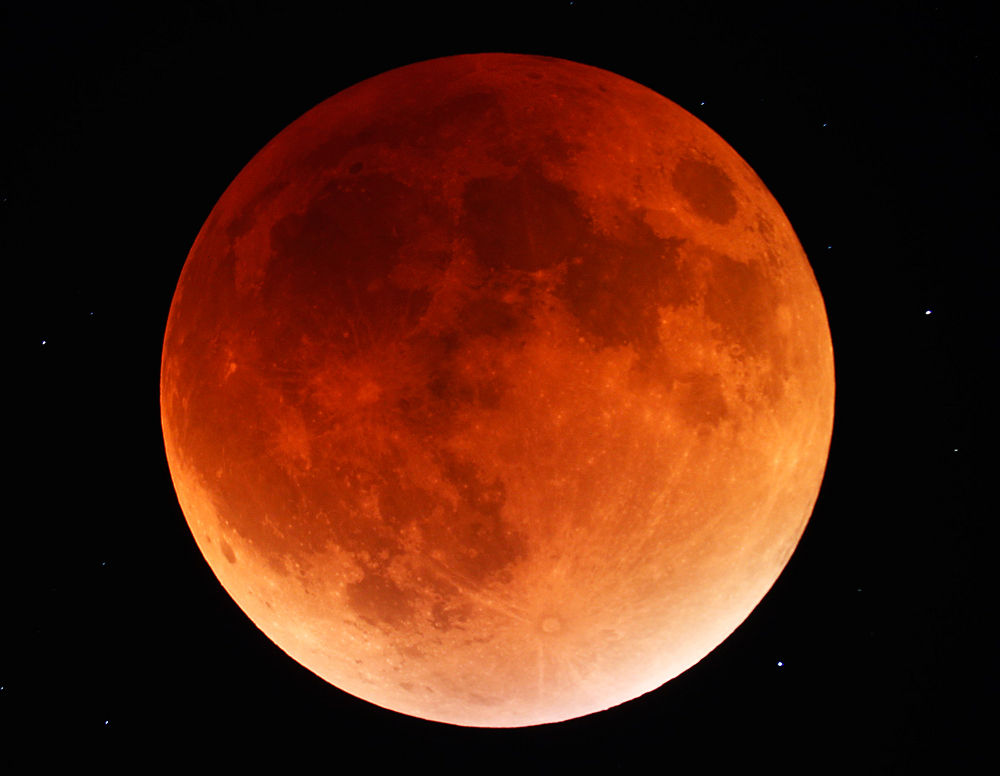
Mike Borman / Online Photo Gallery
John Bortle, a Sky & Telescope contributing editor, chimes in with a detailed account:
Although I've been viewing lunar eclipses since 1953–54, clouds have hampered or obscured the past few events for me. In contrast, most of last night's event occurred in a pristine sky here in Stormville, New York. During totality my NELM was about 6.0 and the Milky Way spanned more than 120° of sky. Not at all bad for a (by today's standards) semi-rural site only 75 miles north of New York City.
Once past first umbral contact, the skies remained perfect and virtually cloud-free until 11:10 p.m. EDT and were then mainly hampered by quite thin clouds which intervened until I quit at 11:55. I judged this eclipse to be quite odd. It resembled one that I recall seeing quite some years ago that was also very bright on the shadow's outer edges but very dark toward the center. I must say that I was initially rather disappointed on easily seeing the eclipsed portion of the disk with 10×50 binoculars when the shadow had advanced only 20% of the way across the lunar disk (9:20 p.m. EDT). Not long after, I saw it with no optical aid. This led me to believe that this would be another bright eclipse like so many recent ones. I was wrong.
I considered the leading 10 arcminutes nearest the shadow's edge to be light dirty-yellow in color and rather bright. Several times early and late in the eclipse, I suspected a vague blue color in the shadow's rim, but I was never certain of it. Deeper in the shadow, the color transitioned to a dull red to the unaided eye. As the eclipse progressed, the bright dirty-yellow outer portion narrowed and was pushed steadily closer and closer to the lunar southwest limb. It then slowly rotated clockwise around the limb through the southernmost area of the disk and around to the southeast limb late in totality.
Around mid-eclipse the area encompassing the northern third of the lunar disk and involving Oceanus Procellarum became very dark, making the northern limb difficult to define with the naked eye shortly after mid-eclipse. During this time colors were muted visually and more nondescript, or brownish-gray, than anything (features show up in a vivid reddish color in my photos, though). I ranked the eclipse as one of the most drab that I recall seeing. Even with my 10-inch Dobsonian at 50×, the colors were quite muted. To me the second half of the eclipse was notably darker overall than the first half.
Ultimately I had to rank the eclipse fractionally on the Danjon Scale, something never intended by Danjon I suppose. The outer portion of the shadow was classic L = 3, while the majority of other aspects and the eclipse's darkness put it squarely class L = 2. So, the final figure I settled on was an L = 2.3 for the event. On the Fisher Scale it was a class 1, since near mid-eclipse I had considerable difficulty making out any of the maria without optical aid. Around mid-eclipse I also judged the moon's integrated magnitude as –1.6 using reversed 10x50 binoculars with appropriate corrections applied. This is quite a contrast to the –3s and –4s of the last couple of eclipses I've viewed in recent years.
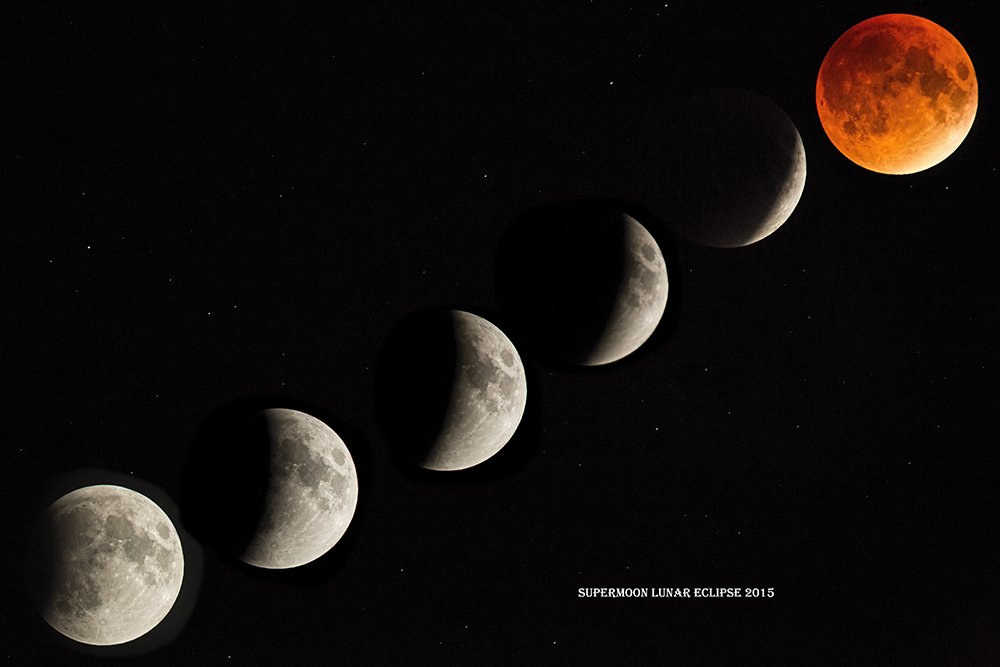
Let us know what detail you saw in the comments below, and be sure to check out more beautiful shots of the lunar eclipse in our online photo gallery (or submit your own)!
Finally, we'll leave the closing word with Peter Tyson, Sky & Telescope's editor in chief, whose thoughts took a philosophical turn during the eclipse.
As I watched the Moon go into and then out of totality last night, I couldn’t stop thinking about Earth. How that curved shadow easing across the face of the Moon was our shadow. How the ancients realized from that curve that our home planet is roughly four times larger than its satellite. How the red-orange disk of the Moon during totality captured light from all the sunrises and sunsets then happening on our world. (As my sister likes to say, "How cool is that?")
Gazing at the Moon during totality, I wondered: If Earth had no atmosphere, would the Moon right now appear more or less black, a hole in the sky otherwise full of stars? More to my frame of mind, what if we could stand on the surface of the Moon during a total lunar eclipse, deep within the umbra, and gaze back at Earth? How would we feel seeing our beautiful blue marble turn completely black before our eyes? What a metaphor, one might argue, for what humanity is doing to that beautiful blue marble.
Perhaps, but my mind wasn’t on apocalypse, not last night. The sight above was too wondrous for that.
 9
9
Comments
Gerald-Hanner
September 29, 2015 at 1:32 pm
From my perspective, here in Papillion, Nebraska, the moon did not turn a ruddy hue at totality. The air was nearly cloudless and, apparently, no smoke from forest fires further west. It was a dark moon here.
You must be logged in to post a comment.
Anthony Barreiro
September 29, 2015 at 2:05 pm
Thanks all. John Bortle describes better than I could how the eclipsed Moon appeared to me during totality, and Peter Tyson captured some of my philosophical reflections. I would add that the ancient Greek astronomer Aristarchus (that's his bright crater in Oceanus Procellarum, and he was the first person we know of who deduced that the Earth orbits the Sun) used the duration of lunar eclipse to calculate that the Moon is about 60 Earth-radii distant from the Earth.
Rather than going to all the trouble of sending humans to the Moon, why not put a video camera and transmitter in the middle of the Earth-facing side of the Moon, pointed at the Earth? It would be cool to be able to see the Earth from the Moon at any time, and when we're watching a total lunar eclipse here from Earth, we could simultaneously see a solar eclipse from the Moon, with a ring of fire around the Earth's circumference.
When this is set up, I'll figure out some way to watch both eclipses at the same time. But in the mean time, I'll forgo real-time digital eclipses. I invited friends to watch the eclipse with me from Bernal Hill in San Francisco. The usually quiet hillside was covered with hundreds of people and lots of dogs, quite a festive occasion for both species. I took 11x56 binoculars and a sturdy tripod and enjoyed sharing the view. There were also an 80 mm refractor and a 15-inch dobsonian (talk about overkill!) set up, and lots of people brought hand-held binoculars. The horizon was cloudy, so we didn't see moonrise, and the Moon didn't clear the cloud bank until half an hour into totality. The rest of the eclipse was filtered through shifting layers of thin clouds. Still, I wouldn't have traded that personal experience for a perfect view of the whole eclipse on a computer or television screen. There's something about standing on the Earth during a perfect syzygy, seeing the Earth's shadow crossing the Moon with your own eyes, that can't be captured virtually, as far as I'm concerned. And there's something about sharing that direct experience with friends and strangers that brings people together in a special way, with a sense of warmth and camaraderie.
You must be logged in to post a comment.
David-Roper
September 29, 2015 at 3:07 pm
Breath taking as seen from our home in South Dakota! We had partly cloudy skies for the beginning of the eclipse that cleared to nearly ideal seeing by totality. A beautiful dark red during the peak then brightening to the color of embers in a campfire before sliding back into the Sun's rays. Definitely did not disappoint!
You must be logged in to post a comment.
September 30, 2015 at 2:48 pm
As this was a dark eclipse I find most of the images of totality featured on the web and here are far too bright and over saturated red, thanks to over eager post processing. It is not like it actually was seen with dark brown hue melding to an lighter orange hue to the south limb. Those who did not see the eclipse may wonder at the accolade "darker than usual eclipse". I wonder if we have lost the art of transmitting to the public the subtle appearance of astronomical objects in real viewing conditions because of the relentless, competitive cranking up of super saturated color use in popular media.
Here is my image taken with a compact Canon Powershot zoomed to 48x. (I was traveling light) and processed to reproduce what I saw with my eyes and small binoculars.
https://sites.google.com/site/skywalkphenomena/dark-eclipse-of-27-september-2015
Martin
You must be logged in to post a comment.
GH Martin
October 2, 2015 at 7:21 pm
I agree with you, Martin. However, it is very difficult to image anything in the night sky and capture its appearance to the unaided eye, other than a short-exposure, wide angle shot of a constellation, say. Interesting, perhaps, but not very photogenic; nor instructive, for that matter.
I will say, though, that your eclipse photos come close. They look pretty much like the photos I took of the eclipse using an older Canon DSLR with a zoom lens at 300mm focal length. I wish S&T had a way to post photos here directly, without having to go through an outside website as you did.
What do you say, Sky & Tel? Surely it shouldn't be to difficult to set up.
You must be logged in to post a comment.
John Bortle
October 1, 2015 at 1:51 pm
I fully concur with Marty0750's comment concerning today's so often heavily enhanced images not conveying the actual visual impression of most astronomical phenomena any longer. I have yet to see an image of this eclipse so far that I feel truly replicates the coloration and darkness of the moon's appearance as seen with the unaided eye during the totality phase. The reds, yellows and even blues seen in most Internet images are too bright and saturated in comparison to their much more subtle coloration seen with just the eye alone when viewed under the excellent viewing conditions like I had at my observing site that night. Even telescopically (25-cm reflector) these colors were much more muted and the lunar disk rather darker than the images suggest.
J.Bortle
You must be logged in to post a comment.
October 3, 2015 at 7:07 pm
It's strange how many different interpretations there are of this eclipse - although I agree most of the web images are too saturated, I have to say I can't recall an eclipse which appeared redder to the naked eye than this one. Perhaps atmospheric conditions have a significant role? I don't think we've had more perfect skies for an eclipse here in Ireland since maybe that of April 1996 (extra special with Hyakutake also in the sky).
You must be logged in to post a comment.
October 4, 2015 at 4:57 pm
The lunar eclipse was a beautiful sight from The Mendip Hills here in Southwest England. By capturing the spectrum of the blood moonlight it also presented a rare opportunity to detect the presence of thin gases in the Earth's atmosphere such as ozone. I managed to do just that using a low resolution, slit spectroscope focused through my telescope onto Tycho crater which has a high albedo and lay in the more brightly illuminated southern part of the eclipsed Moon. Here is a link to the presentation I posted on my public Facebook page with the normalised spectrum of blood moonlight compared to the uneclipsed Full Moon. This kind of work hints at the possibilities for the spectral analysis of exoplanet atmospheres using the giant telescopes that will come on line in the next decade. https://www.facebook.com/photo.php?fbid=774858122625385&set=a.507862219324978.1073741828.100003036126065&type=3&theater
You must be logged in to post a comment.
GH Martin
October 4, 2015 at 10:57 pm
I don't know where else to report this -- does S & T have an open message site?
At any rate, I just witnessed an incredible sight. As the International Space Station was passing over my location at Monticello, Ind. (just north of Lafayette), a meteor went right by it on a parallel course in the same direction — visually, very close -- separated by only a degree or two. Since the ISS was at an elevation of about 66º at the time, the meteor was passing very nearly underneath the ISS. It would have passed through the ISS’s altitude at pretty nearly the same time the ISS was there. In other words, the crew of the Space Station had a very close call. This happened at right about 9:00 PM EDT. The meteor was about 3rd magnitude and fairly slow moving. Both the ISS and the meteor were traveling from SW to NE.
To the eye, the meteor was traveling somewhat faster than the ISS, but then, it had to be a lower altitude so it would have appeared faster even if it had the same velocity.
Rather scary, after having seen the movie Gravity. I wonder if the crew of the ISS saw it? I wonder if NASA is aware?
You must be logged in to post a comment.
You must be logged in to post a comment.